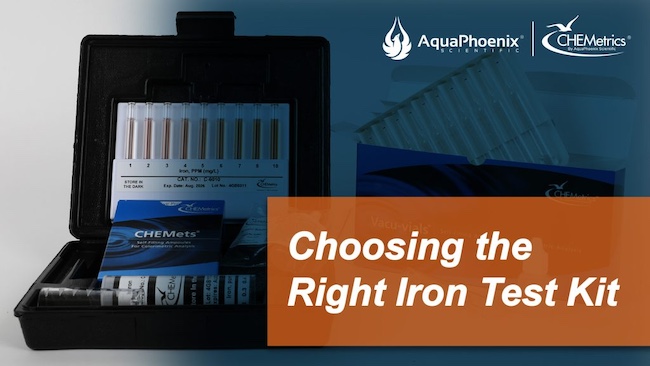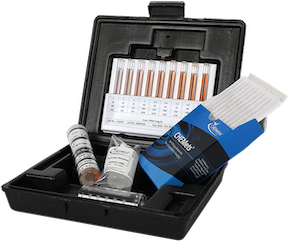Choosing The Right Iron Test Kit
For Your Application

Reasons for Measuring Iron in Water
Many businesses need to measure the concentration of iron in water. Beverage, drinking water, textile, and laundry industries measure iron to prevent discolouration and off-flavours that it can cause. Oil, gas, mining, boiler, and cooling water applications measure iron as it can lead to harmful scaling or indicate corrosion of metal components. Aquaculture businesses measure iron as high concentrations can be toxic to health and growth of their crop. If a business isn’t measuring iron in their processes, it is likely being measured in the wastewater it generates. While the need for reliable iron test kits is obvious, deciding which test kit is right for you can be difficult due to the chemistry of iron.
Forms of Iron
Iron naturally exists in three different chemical oxidation states, Fe0 for metallic elemental iron, ferrous (Fe2+) and ferric (Fe3+). Ferrous iron is water soluble, whereas ferric iron is only soluble below pH 3.5. Above that it is present in particulate or colloidal forms. Depending on conditions such as the levels of oxygen in the water and pH, most natural waters contain a mixture of ferrous and ferric iron, the sum of which is known as Total Iron.
Total Iron = Ferrous Iron + Ferric Iron (both soluble & insoluble forms)
Measuring Iron
CHEMetrics offers two methods for the analysis of iron: 1,10-phenanthroline and ferric thiocyanate. Each is referring to the name of the complexing agent that detects dissolved iron by forming a coloured compound. The 1,10-phenanthroline method is most commonly used and is the focus of this article, while the ferric thiocyanate test is most often used for oil & gas applications where iron is measured in brine solutions.
The 1,10-phenanthroline method can provide you with 4 different iron measurements: ferrous iron, ferric iron, soluble iron and total iron. Each type of iron measurement has different applications that can be useful to a water treatment professional. Both ferric iron and total iron measurements are estimates.
CHEMetrics Iron Test Kits are available in both visual format (pictured left) and instrumental format (pictured right). Based on CHEMetrics patented Self-Filling Reagent Ampoule technology for simple, snap-and-read testing. Premixed. Premeasured. Precise.


Ferrous Iron
| Test Kit | Range | Class | Measurement | Type |
|---|---|---|---|---|
| K-6210 | 0.0 - 1.0 & 1 - 10 ppm | Visual | Total & Ferrous | CHEMets |
| K-6220D | 10 - 100 ppm | Visual | Total & Ferrous | HR CHEMets |
| K-6203 | 0 - 6.00 ppm | Instrumental | Total & Ferrous | Vacu-vials |
If the goal is to only measure the concentration of ferrous iron (Fe2+) in your water sample, use the CHEMetrics K-6210, K-6220D or K-6203 test kits. The 1,10-phenanthroline readily forms an intense reddish orange complex with ferrous iron. This reagent is sealed inside the CHEMetrics ampoules.
Ferrous iron is the most soluble form of iron. Measuring ferrous iron is common when you only want to measure the dissolved iron in your sample. This is particularly important in water treatment or applications where you are anticipating the iron to precipitate out of the solution and want to know how much there will be. Measuring ferrous iron may also be necessary for determining the concentration of ferric iron (Fe3+). The general procedure to indirectly measure ferric iron is to subtract the ferrous iron test result from the measured total iron / soluble iron test result.
Ferric Iron
| Test Kit | Range | Class | Measurement | Type |
|---|---|---|---|---|
| K-6210 | 0.0 - 1.0 & 1 - 10 ppm | Visual | Total & Ferrous | CHEMets |
| K-6220D |
10 - 100 ppm | Visual | Total & Ferrous | HR CHEMets |
| K-6203 | 0 - 6.00 ppm | Instrumental | Total & Ferrous | Vacu-vials |
Estimating ferric iron requires two test results and then a calculation. The two tests can be performed with either the CHEMetrics K-6210, K-6220D or K-6203 test kits.
To measure ferric iron by the 1,10-phenanthroline method, two separate tests must be performed, the total iron and then ferrous iron. Then the estimated ferric iron content of the sample is calculated by subtracting ferrous iron only from total iron. See below for the total iron procedure.
Estimate of Ferric Iron = Total Iron – Ferrous Only
Ferric iron is most frequently measured to assess corrosion. Since it is insoluble it is most likely to clog filters and pipes. Routine monitoring can help prevent damage to industrial infrastructure. It is also commonly measured in environmental applications as the iron can react with pollutants and is an indicator of biological activity.
Soluble Iron
| Test Kit | Range | Class | Measurement | Type |
|---|---|---|---|---|
| K-6010 | 0.0 -1.0 & 1 - 10 ppm | Visual | Total & Soluble | CHEMets |
| K-6020D |
10 - 100 ppm | Visual | Total & Soluble | HR CHEMets |
| K-6020A |
50 - 500 ppm | Visual | Total & Soluble | HR CHEMets |
| K-6020B |
250 - 2,500 ppm | Visual | Total & Soluble | HR CHEMets |
| K-6003 | 0 - 6.00 ppm | Instrumental | Total & Soluble | Vacu-vials |
The CHEMetrics K-6010, K-6020x and K-6003 ampoules contain hydroxylamine hydrochloride in addition to 1,10-phenanthroline. This compound is a mild reducing agent, making it suitable for measuring all iron species that are readily solubilised. These tests are best for water samples that are not expected to have significant levels of unreactive insoluble iron.
Examples of suitable sample matrices that are applicable to the above test kits:
- Acidified iron standard solutions available commercially
- Recently prepared solutions from soluble iron salts (e.g. nitrates, chlorides, sulphates)
- Natural water that exhibits conditions which discourage ferric iron formation (e.g. low oxygen and low pH).
If you obtain a value that is significantly lower than expected (e.g. based on historical data), it implies the presence of other interfering oxidising compounds or that the more rigorous total iron procedure with / without acid digestion is needed.
The ferrous iron test differs from the soluble iron test in that it does not contain hydroxylamine hydrochloride, so it will not be able to solubilise compounds with refractory characteristics and will not measure any type of insoluble iron.
The soluble iron test is best conducted by experienced operators who understand their testing conditions well.
Total Iron
| Test Kit | Range | Class | Measurement | Type |
|---|---|---|---|---|
| K-6010 | 0.0 -1.0 & 1 - 10 ppm | Visual | Total & Soluble | CHEMets |
| K-6020D |
10 - 100 ppm | Visual | Total & Soluble | HR CHEMets |
| K-6020A |
50 - 500 ppm | Visual | Total & Soluble | HR CHEMets |
| K-6020B |
250 - 2,500 ppm | Visual | Total & Soluble | HR CHEMets |
| K-6003 | 0 - 6.00 ppm | Instrumental | Total & Soluble | Vacu-vials |
| K-6210 | 0.0 - 1.0 & 1 - 10 ppm | Visual | Total & Ferrous | CHEMets |
| K-6220D |
10 - 100 ppm | Visual | Total & Ferrous | HR CHEMets |
| K-6203 | 0 - 6.00 ppm | Instrumental | Total & Ferrous | Vacu-vials |
All above CHEMetrics 1,10-phenanthroline-based iron test kits can be used to estimate total iron. This is possible by the inclusion of the A-6000 Activator Solution, which contains thioglycolic acid and ammonium thioglycolate. Thioglycolic acid (HSCH2-COOH) is a reducing agent, effective at dissolving and converting most insoluble and particulate forms of iron to the ferrous state. A well-ventilated work area is strongly advised due to the odour. The Activator Solution is added to the sample and is left for 4 minutes prior to drawing the sample into the ampoule.
The A-6000 Activator Solution is incompatible with samples containing molybdates (MoO42-). Also, samples containing nitrites (NO2–) must first be fully treated with A-9600 (Sulphamic acid, H3NSO3) before performing the A-6000 procedure. See the Technical Data Sheet for more information.
Analysts should be aware, however, there are insoluble ferric iron forms that have refractory characteristics. This means they resist conversion to the ferrous iron form. Examples of unreactive iron minerals are magnetite and ferrite. In that situation samples must be digested (refluxed or boiled) in strong acids to bring those forms of iron into solution.
In environmental monitoring applications, USEPA guidelines require digesting the sample in strong acid which provide more aggressive conditions prior to analysis that will ensure a more complete total iron recovery. For high frequency testing, analysts can evaluate the disparity of results obtained with and without acid digestion to decide if the additional time expense is justified for future analyses.
Total iron measurements are often made for boiler and cooling water system monitoring, general water quality, safety, and environmental regulatory compliance.
Further Information and Where to Purchase
All of the CHEMetrics iron test kits are listed on the Iron Test Kits page. If you need further assistance, have a question or would like a quote, do not hesitate to contact us.